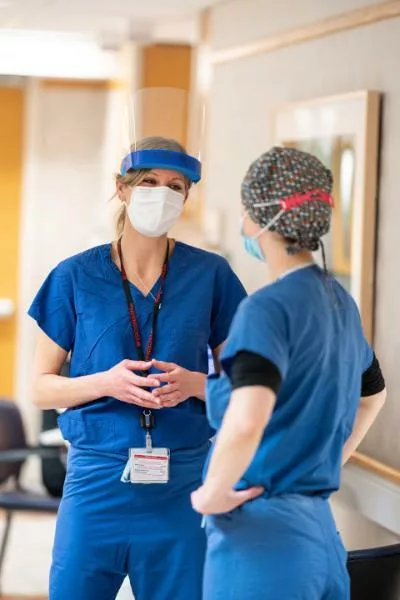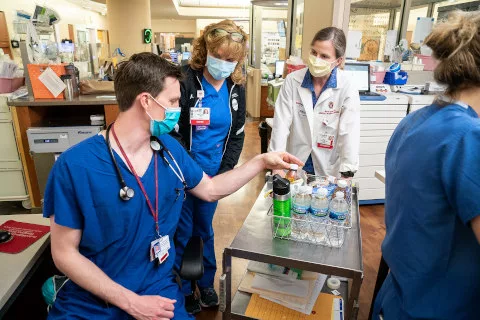Perspectives: Once in a Lifetime
Having meticulously curated an exhibit on World War I and the 1918 influenza pandemic, Micaela Sullivan-Fowler compares that outbreak to the ongoing COVID-19 pandemic.
As COVID-19, caused by the highly infectious SARS-CoV-2, reached pandemic status in March 2020 and progressed throughout the United States — resulting in unprecedented personal and professional challenges — a strong message emerged: “We’re all in this together.”
Describing this era, University of Wisconsin School of Medicine and Public Health (SMPH) Dean Robert N. Golden, MD, says, “To turn Charles Dickens’ quote upside down, I would say these are the worst of times, and these are the best of times.”
He explains, “It’s clearly the worst pandemic in the past century. But, it’s amazing how this is bringing out the very best in people and in our institution.”

Noting that his already-strong pride about the SMPH grows daily as he witnesses faculty and staff “banding together to battle this horrible pandemic,” he says the efforts build upon the school’s tripartite missions: clinical care, research and education.
“I am in awe of the bravery and dedication of our physicians, nurses and other front-line workers. I am profoundly impressed with the resilience of our students, who made ‘lemonade out of lemons’ when COVID-19 forced their Match Day and graduation events to go virtual. Further, many staff members have found innovative ways to advance our missions while following the best public health practices. And administrators at our school, university and UW Health have shown remarkable leadership and self-sacrifice,” notes Golden.
At UW Health, the pandemic caused a race to open the Health Incident Command Center, acquire ample personal protective equipment (PPE), train people how to safely use it, and find ways to maximize its lifespan amid severe national shortages.
While countless faculty members are working tirelessly on the COVID-19 response, Golden describes several who are working around the clock to connect with local, state and national agencies, including the U.S. Centers for Disease Control and Prevention (CDC). They are Nasia Safdar, MD, PhD (PG ’00), professor, Department of Medicine, SMPH, and medical director of infection control, UW Health; Peter Newcomer, MD ’95, senior associate dean for clinical affairs, SMPH, and chief clinical officer, UW Health; Jeffrey Pothof, MD ’06, associate professor, BerbeeWalsh Department of Emergency Medicine, SMPH, and chief quality officer, UW Health; Aimee Becker, MD ’01 (PG ’05, ’06), MBA, associate professor, Department of Anesthesiology, SMPH, and chief medical officer and vice president, inpatient operations, UW Health; and Matthew Anderson, MD, clinical associate professor,Department of Medicine, SMPH, and senior medical director, primary care, UW Health.
In record time, faculty and staff established 24/7 sessions in the UW Health Clinical Simulation Program and taught hundreds of health care workers how to safely don and doff PPE. Personnel dedicated herculean efforts to adapt clinical facilities to assure safety for patients and caregivers. Tapping into and adding to the national COVID-19 knowledge base, health care providers implemented many innovations to avoid unnecessary exposure to the virus.
The SMPH and UW Health formed collaborations with the UW–Madison College of Engineering to source items that protect health care workers. For instance, UW–Madison engineers worked with Madison-area manufacturers, the design consulting firm Delve, and UW Health faculty and staff to produce medical face shields — which were unavailable from usual supply chains. They frequently consulted with Robert Scheuer, UW Health director of materials management, to ensure a medical-grade product. The group published its design as open source to be shared worldwide.
Addressing another critical need, a team of surgeons, anesthesiologists and engineers — led by Hau Le, MD, assistant professor, Departments of Surgery, Pediatrics and Biomedical Engineering — in collaboration with the Sector 67 makerspace, developed the Box for Aerosol and Droplet Guarding and Extraction in Respiratory Infection (BADGER). It is placed above a patient’s upper body and head to contain viral particles during procedures that have a high risk of disease transmission. Designs for the negative-pressure BADGER are being provided for free to other health care systems.
When COVID-19 appeared in the region, UW Health and other area health systems temporarily suspended nonessential patient visits, procedures and surgeries to prepare for potential surges of the virus. They also ramped up telehealth services.
Tom Brazelton, MD, MPH, medical director of UW Health’s Telehealth Program and a professor in the SMPH Department of Pediatrics, says the field “exploded,” from a small service (see Quarterly, Volume 22, Number 1) into a high-demand commodity. The program has been able to train more than 2,000 providers to use the system since mid-March. Brazelton anticipates that patient demand for virtually delivered health care will remain high forever. The technology also allows providers inside a COVID-19 patient’s room to communicate with those outside the room, reducing exposure and PPE usage.
Laboratory services also blossomed to meet pandemic-related needs. The Wisconsin State Laboratory of Hygiene — a key partner with the SMPH (see Quarterly, Volume 22, Number 1) — has been working in concert with the CDC and other agencies as it conducts COVID-19 tests and helps laboratories around Wisconsin develop diagnostic capabilities. UW Health is among those that established in-house testing.
Unless research could be conducted remotely, directly benefited patient care or gained permission related to COVID-19, studies were temporarily halted in March.
Describing pertinent investigations, Golden notes, “Our researchers are doing amazing things. For instance, Dr. Miriam Shelef had the early foresight to bank specimens from recovered patients so they are available for use in research projects.”
Several SMPH programs are working with county, state and national entities to conduct COVID-19 research. Approved clinical trials are being managed centrally through an institutional process at the school. The descriptions below include only a small sampling of the efforts underway.
By early February, David O’Connor, PhD, professor, SMPH Department of Pathology and Laboratory Medicine, and Thomas Friedrich, PhD, professor, UW School of Veterinary Medicine, reinvigorated previous research to study the virus.
“We are working to develop a plan to build out nonhuman primate models to test medical countermeasures such as vaccines and therapeutics,” says O’Connor. “We want to make sure we are recapitulating the kind of clinical signs (of virus infection) that happen in people.”

They are interested in understanding how much of the virus makes its way into the body and in bodily fluids, and where in the lungs the virus infects; and they aim to create opportunities to test new vaccines and antivirals. They also hope to look at how the immune system responds and whether there are indicators that can help distinguish who might be at risk for developing severe disease.
The SMPH and UW Health are part of a large national consortium, led by Mayo Clinic, that is investigating the use of convalescent plasma to determine whether it can shorten the duration or severity of illness from COVID-19. William Hartman, MD, PhD, assistant professor (CHS), Department of Anesthesiology, is the local principal investigator of the trial, which uses antibodies from people who have recovered from COVID-19 as an experimental treatment for seriously ill patients. The first UW Health patient was treated in mid-April.
Another principal investigator, Daniel Jackson, MD ’03 (PG ’10), published a study indicating that respiratory allergies, asthma and controlled allergen exposure were associated with significantly reduced gene expression in a protein the coronavirus uses to infect cells with COVID-19. The research suggests a possible reason why people with respiratory allergies and asthma do not appear to be at increased risk of COVID-19. Importantly, previous studies have shown that higher expression of ACE2 is associated with smoking, diabetes and hypertension, which are risk factors for COVID-19 disease severity.
The Wisconsin Partnership Program at the SMPH has awarded 22 COVID-19 Response Grants totaling $2.7 million. Grants support vital research at the SMPH and across campus, including projects for COVID-19 vaccines and treatments; grants also help community organizations address the immediate health needs of Wisconsin’s diverse urban and rural communities.
“We are pleased to support a broad range of innovative projects, including those that aim to advance health equity by supporting the most vulnerable in our communities,” comments Golden. “This approach is well aligned with our mission to improve health and well-being in Wisconsin.”

Golden recalls the “heavy lift” required by a large team — led by key medical education administrators — to convert the school’s educational offerings into online deliverables due to the pandemic.
Elizabeth Petty, MD ’86 (PG ’89), senior associate dean for academic affairs, co-authored — with William J. Hueston, MD, of the Medical College of Wisconsin — an article, “Impact of the COVID-19 Pandemic on Medical Student Education in Wisconsin,” in the Wisconsin Medical Journal. The article described complications faced by students in nonclinical and clinical portions of the curriculum when gatherings were banned to slow the community spread of the virus.
“I am immensely grateful for the talent, tenacity and thoughtful collaboration of our faculty members, education teams, and academic information services and educational technology staff as they embraced different ways to deliver curriculum in this time of unprecedented change. They quickly deployed virtual courses, including some new courses, for students when face-to-face classes and hands-on clinical learning were abruptly suspended,” says Petty, adding that this helped final-year students graduate.
Jonathan Temte, MD ’87, PhD (PG ’93), SMPH associate dean for public health and community engagement, and a professor in the Department of Family Medicine and Community Health, is serving as the American Association of Family Physicians’ representative on the CDC’s Advisory Committee on Immunization Practices COVID-19 Work Group.
He and Golden, in an editorial titled “A Prescription for a Healthier Wisconsin in the COVID-19 Era,” wrote, “The dramatic shift in our collective behaviors has required great sacrifice. Our lives have changed, financial distress has devastated families and businesses, and the acute and cumulative stresses grow in intensity each day.”
They outlined many future steps to recovery — including access to COVID-19 testing, contact tracing, isolation of infected individuals, tracking community spread, protecting individuals with PPE, assuring health care access for all, and responsibly reopening businesses and activities while monitoring data to assure safety.
Temte and Golden also provided a hopeful outlook, stating, “With strong conviction and an emphasis on evidence rather than emotion, we will get through this pandemic — but only if we are united by a shared vision. … Our recovery from COVID-19 will not follow a straight line. There will be inevitable flare-ups of new infections, at least until we have a safe and effective vaccine that is available for everyone. But by having the proper systems and resources in place, we can avoid having each flare-up turn into a raging, destructive forest fire that takes the lives of Wisconsinites.”